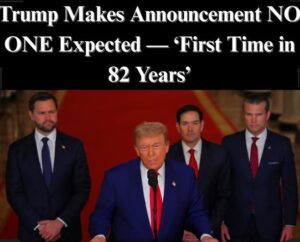Trump Plans Historic Visit to Fort Knox: First Presidential Inspection in Over 80 Years

Former President Donald Trump has announced his intent to personally inspect the gold reserves at Fort Knox, a bold move that would mark the first such presidential visit since Franklin D. Roosevelt’s trip to the facility in 1943—more than eight decades ago.
“We’re going to Fort Knox to make sure the gold is really there,” Trump declared during a recent address, reviving long-standing public curiosity about the legendary U.S. Bullion Depository.
According to the U.S. Mint, the vault has not been visited by any outside individual—not even government officials—since Roosevelt’s era, making Trump’s potential tour a historic first in modern times. The idea, while not confirmed as an official plan, has been repeatedly brought up by Trump in recent months. Back in February, he teased reporters with similar remarks, saying, “We’re going to take a look. We’re going to Fort Knox.”
The former president emphasized the importance of verifying the contents, adding, “We just want to make sure the gold is still there. That’s all. Hopefully, everything checks out.”
When asked by a journalist what would happen if the gold had somehow vanished, Trump responded, “If it’s not there, we’re going to be very disappointed.”
Current data from the United States Bullion Repository reports a total of 147.3 million ounces of gold held at Fort Knox, which, based on current market prices of $2,950.01 per ounce, is worth around $435 billion.
Fort Knox, located roughly 35 miles south of Louisville, Kentucky, is more than just a vault. It spans over 109,000 acres across Bullitt, Hardin, and Meade counties and houses the U.S. Army’s Human Resources Command. It’s also the site of the Army’s largest training event each year.
Originally established as Camp Knox during World War I, the site officially became Fort Knox in 1932. It received its first shipment of gold in 1937, under tight protection from the 1st Cavalry Regiment.
The depository has become synonymous with security. During World War II, Fort Knox also played a crucial role in armored warfare training. For decades, it’s been affectionately known as the “Home of Cavalry and Armor.”
Security protocols at the Fort Knox depository are famously secretive. The vault’s layout and access methods are only partially known, with no single individual having complete knowledge of the system. The building itself, constructed in 1936, boasts 16,000 cubic feet of granite, over 4,000 cubic yards of concrete, and hundreds of tons of steel for reinforcement.
Public access is virtually nonexistent. Only three groups have ever been allowed inside since its construction, all under exceptional circumstances. Gold rarely leaves the facility—only small quantities have been removed over the years for testing and verification of purity.
In response to Trump’s plan, Kentucky Senator Mitch McConnell offered a tongue-in-cheek comment during a Senate budget session. After Army Secretary Daniel Driscoll visited Fort Knox, McConnell quipped, “Did you check on the gold while you were there?” The remark drew laughter from the room, a subtle jab at Trump’s repeated suspicions about the gold’s whereabouts.
Trump, however, remains insistent. “We’re opening the doors. We’re going to look inside Fort Knox,” he proclaimed during a recent speech. “I don’t want to walk in there and find nothing but dust.”
If the visit does take place, it would be a rare moment in presidential history—and potentially reignite public debate over transparency and trust in one of America’s most mysterious and iconic institutions.